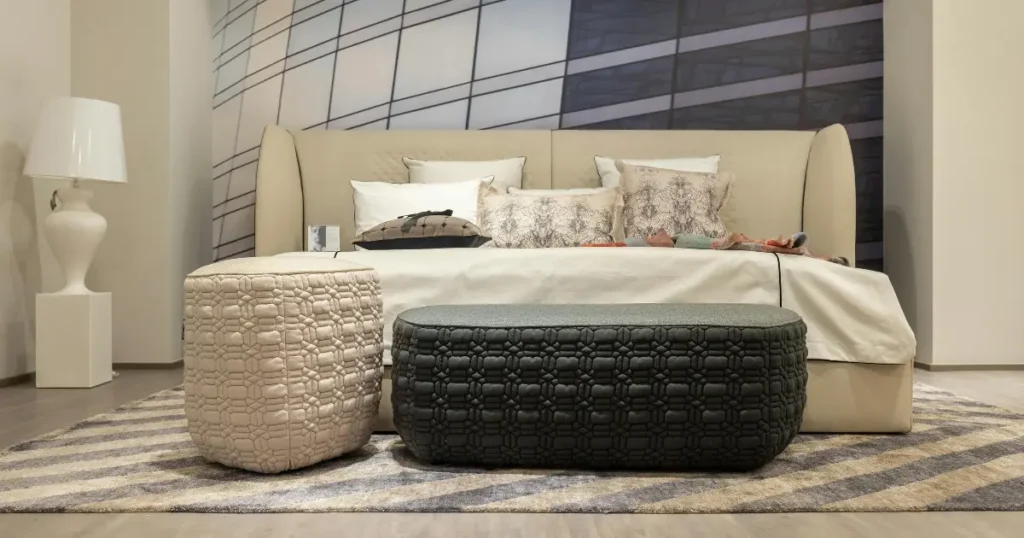Hanging a rug on the wall is a unique and stylish way to add texture, color, and warmth to your home decor. Not only does it create an eye-catching focal point, but it also showcases your personal style in a fun and creative way. Whether you want to highlight a beautiful handmade piece, embrace a bold pattern, or simply add a cozy touch to your living space, knowing how to hang a rug on the wall can elevate your interior design game.
In this friendly guide, we’ll explore various methods and tips to ensure your rug is not only visually stunning but also securely displayed. From choosing the right hardware to preparing your wall, we’ve got you covered! So, grab your favorite rug and let’s dive into the best techniques for successfully hanging a rug on the wall. Transform your space and make it truly yours with this delightful decor idea!
Why Hang a Rug on the Wall?

Hang a rug on the wall is a creative way to add personality to your living space. Unlike traditional wall art, rugs bring a unique texture and warmth that can transform the ambiance of a room. Here are some reasons why you might consider hang a rug on the wall:
| Aesthetic Appeal | Rugs, especially those with intricate designs or cultural significance, can be beautiful focal points |
| Preservation | Displaying a rug on the wall protects it from wear and tear, preserving its quality and longevity |
| Space Optimization | If you have limited floor space, hang a rug on the wall is a way to enjoy it without cluttering your room |
| Versatility | Rugs come in various sizes, colors, and patterns, making them versatile decorative pieces that can match any room decor |
Choosing the Right Rug for Wall Hanging

Not every rug is suitable for wall hanging. When selecting a rug to display on the wall, consider the following factors:
Material
- Wool Rugs: Wool is durable and resilient, making it a good choice for wall hanging. It’s also naturally flame-resistant.
- Silk Rugs: Silk rugs are delicate and should be handled with care. They are lightweight, making them easier to hang but may require more protection from dust and sunlight.
- Cotton Rugs: Cotton is light and easy to hang, but it might not be as durable as wool or silk.
Weight
The rug’s weight will determine the hanging method. Heavier rugs may require more robust support, such as a wooden frame or sturdy rod.
Design
When you decide to hang a rug on the wall, choose a design that complements your room’s decor. Whether it features a bold geometric pattern or a subtle traditional motif, the rug should enhance the room’s visual appeal and serve as a striking focal point.
How to Mount a Rug on the Wall
To hang a rug on the wall, use rug clips, Velcro strips, or a rod for support. Measure and mark the wall to ensure the rug hangs straight and centered. Secure the rug with your chosen method and make any necessary adjustments.
How to Hang a Rug on the Wall? Methods and Techniques
To hang a rug on the wall, use rug clips, Velcro strips, or a curtain rod. Measure and mark the wall to ensure it’s centered and level. Secure the rug and make any final adjustments for alignment.

There are several ways to hang a rug on the wall, depending on its size, weight, and material. Here’s a detailed look at each method:
Using a Rod and Sleeve
Prepare the Rug: If your rug doesn’t already have a sleeve (a fabric loop sewn onto the back), you can sew one yourself using a durable fabric.
Install the Rod: Choose a decorative rod that complements your rug and room decor. Mount the rod brackets securely on the wall.
Hang the Rug: Slide the rod through the sleeve and hang it on the brackets.
Pros:
- Provides strong support.
- Allows easy removal for cleaning.
Cons:
- Requires sewing if the rug doesn’t have a sleeve.
- Rods can be expensive.

Velcro Strips
Attach Velcro to the Rug: Sew one side of the Velcro strip along the top edge of the rug.
Mount the Other Side on the Wall: Attach the corresponding Velcro strip to the wall using screws or nails.
Hang the Rug: Press the rug’s Velcro side onto the wall-mounted strip.
Pros:
- Easy to install and remove.
- No visible hardware.
Cons:
- Velcro may weaken over time.
- Not suitable for heavy rugs.
Clamps and Clips
Select Clamps or Clips: Choose decorative clamps or clips that are strong enough to hold the rug.
Install the Clamps on the Wall: Secure the clamps to the wall, ensuring they are level and evenly spaced.
Hang the Rug: Place the rug inside the clamps, adjusting as necessary to ensure it hangs straight.
Pros:
- Minimal damage to the rug.
- Adjustable and versatile.
Cons:
- Clamps might leave marks on delicate rugs.
- Requires precise measurement to keep the rug straight.

Adhesive Strips
Prepare the Wall: Clean the wall surface where the rug will be hung.
Attach Adhesive Strips to the Rug: Apply heavy-duty adhesive strips to the back of the rug.
Mount the Rug on the Wall: Press the rug onto the wall, ensuring it adheres evenly.
Pros:
- No drilling or hardware required.
- Quick and easy installation.
Cons:
- Adhesive might damage the rug or wall over time.
- Not ideal for heavy or large rugs.
Wooden Frame
Build the Frame: Construct a wooden frame slightly smaller than the rug’s dimensions.
Mount the Rug on the Frame: Stretch the rug over the frame and secure it with staples or nails.
Hang the Frame on the Wall: Mount the frame using heavy-duty brackets or hooks.
Pros:
- Provides excellent support for heavy rugs.
- Protects the rug from sagging.
Cons:
- Requires more effort and tools to construct.
- Frame adds weight to the installation.
How to Frame a Rug for Hanging
To hang a rug on the wall, first choose a frame that fits the rug’s dimensions. Secure the rug inside the frame using a backing board or mounting pins. Once framed, hang the rug using sturdy wall hooks or brackets for support.
Tools and Materials Needed

Basic Tools
| Tool | Description |
|---|---|
| Measuring Tape | For accurate measurements of the rug and wall space. |
| Level | Ensures the rug hangs straight. |
| Drill | Necessary for installing brackets, clamps, or hooks. |
| Scissors | For cutting fabric or Velcro strips. |
| Sewing Kit | For attaching sleeves or Velcro to the rug. |
Rug Hanging Hardware
| Hardware | Description |
|---|---|
| Rods & Brackets | Supports the rug and adds decorative elements. |
| Velcro Strips | Provides a flexible and removable hanging option. |
| Clamps & Clips | Holds the rug without causing significant damage. |
| Adhesive Strips | Offers a quick and hardware-free hanging method. |
| Wooden Frame | Adds structure and support, especially for heavy rugs. |
How to Hang a Heavy Rug on the Wall
To hang a rug on the wall, use a strong rod or heavy-duty rug clips for support, especially for heavier rugs. Ensure the wall has proper anchors or studs to hold the weight securely. Use a level to make sure the rug hangs straight and evenly.
How to Hang Carpets on Wall
To hang a rug on the wall, use sturdy rug clips, Velcro, or a rod for support. Measure and mark the wall for proper alignment, ensuring it’s straight with a level. Secure the rug evenly and make adjustments as needed for a polished look.
Protecting and Maintaining Your Rug

Once the rug is on the wall, proper maintenance is essential to keep it looking its best. Here are some tips:
Regular Cleaning
- Dust Regularly: Use a vacuum with a soft brush attachment to remove dust. Do this at least once a month.
- Avoid Direct Sunlight: Prolonged exposure to sunlight can fade the colors. Use UV-protective window films or curtains to protect the rug.
Inspect for Damage
- Check for Wear: Regularly inspect the rug for any signs of wear, such as fraying or loose threads.
- Repair Promptly: Address any damage immediately to prevent it from worsening.
Rotate the Rug
- Prevent Sagging: If possible, rotate the rug every few months to distribute wear evenly and prevent sagging.
Common Mistakes to Avoid

Hanging the Rug Without Support
Avoid hanging heavy rugs on the wall without adequate support. Improper hanging methods can lead to sagging, stretching, or even damaging the rug over time. Always ensure that the method you choose to hang a rug on the wall provides sufficient support for the weight and size of the rug. By selecting the right approach, you can protect your investment and maintain the beauty of your rug for years to come.
Using Inappropriate Materials
Choosing the wrong materials to hang a rug on the wall, such as weak adhesive strips for a heavy rug, can lead to the rug falling and potentially damaging both the rug and the wall. It’s crucial to select materials that are appropriate for the weight and type of rug you want to display. By ensuring that you use the right support and hanging solutions, you can safely hang a rug on the wall while preserving its beauty and your wall’s integrity.
Ignoring Wall Preparation
Before you hang a rug on the wall, ensure that the wall is clean and properly prepared. Dust, dirt, or uneven surfaces can affect how well the rug hangs and adheres to the wall. This is especially important if you’re using adhesive strips, as a clean surface will help ensure a secure bond. Taking the time to prepare your wall properly will not only enhance the appearance of your rug but also ensure that it stays in place and maintains its beauty over time.
Overexposing the Rug to Sunlight
To prevent your rug from fading, especially if it has natural dyes, consider hanging a rug on the wall in a location that doesn’t receive direct sunlight. Alternatively, you can use UV-blocking window treatments to protect the rug from harmful rays. Hanging a rug on the wall not only enhances its longevity but also adds a decorative touch to your interior space.
Not Measuring Properly
Incorrect measurements can lead to a crooked or off-center display. Always measure both the rug and the wall space carefully, and use a level to ensure the rug hangs straight.
Conclusion
Hang a rug on the wall is a creative and stylish way to showcase its beauty and craftsmanship. Whether it’s a cherished heirloom, a valuable collectible, or simply a rug that complements your decor, displaying it on the wall can transform it into a piece of art. By choosing the right rug, preparing it properly, and using the appropriate hanging method, you can ensure that your rug remains a stunning focal point in your home for years to come.
Remember to consider the rug’s material, weight, and the room’s lighting before deciding on a hanging method. Regular maintenance, such as dusting and rotating the rug, will also help preserve its beauty and integrity. Avoid common mistakes like improper support, inadequate materials, and overexposure to sunlight to keep both the rug and your wall in great condition.
With this comprehensive guide, you now have the knowledge and tools to successfully hang a rug on the wall. Whether you’re enhancing a modern living room or adding a touch of tradition to a cozy den, your wall-hung rug is sure to be a conversation starter and a cherished piece of your home’s decor.
FAQs
What is the best method to hang a rug on the wall?
The best method depends on the rug’s size, weight, and material. For most rugs, using a rod and sleeve or Velcro strips offers a secure and aesthetically pleasing option. Heavy rugs may require more robust methods, such as a wooden frame or clamps.
Can any rug be hung on a wall?
Most rugs can be hung on a wall, but some materials, like very delicate silk or extremely heavy rugs, may require special care. Consider the rug’s weight, size, and material before deciding on the best method.
How do I hang a heavy rug on the wall?
For heavy rugs, using a wooden frame or sturdy rod and brackets is recommended. These methods provide the necessary support to prevent sagging and ensure the rug stays securely on the wall.
Will hanging a rug damage the wall?
Hanging a rug properly should not damage the wall. However, using adhesive strips or improperly secured hardware can leave marks or cause damage. To avoid this, choose the right hardware and ensure it is installed correctly.
How can I prevent my rug from sagging when hung on the wall?
To prevent sagging, ensure the rug is evenly supported along the top edge. Using a rod and sleeve or securing the rug to a wooden frame can help maintain its shape and prevent sagging over time.
